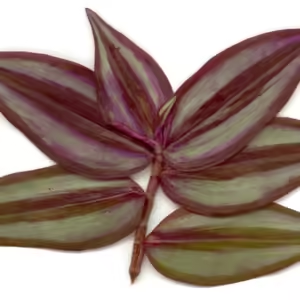Botanical Characteristics
Scientific Classification
The Wandering Jew belongs to the Commelinaceae family, which includes many species known for their attractive value. Tradescantia zebrina, recognized for its striking zebra-like stripes, and Tradescantia pallida, celebrated for its vibrant purple leaves, are two of the most notable species. This family is celebrated for its diverse range of plants, many of which are popular as houseplants due to their appealing appearance and ease of care.

Physical Description
The plant features lance-shaped leaves with purple, green, and silver stripes. This unique color contrast adds visual interest and creates an energetic display as the leaves catch the light. It commonly exhibits a creeping growth habit, with stems that cascade over the edges of pots, making it ideal for hanging baskets or as ground cover.
Growth Patterns
As a vining and creeping species, the Wandering Jew plant commonly grows to a height of about 6-12 inches. Its trailing growth allows for quick coverage, making it effective for filling garden gaps or creating lush displays. Their rapid growth rate makes them a favorite among gardeners looking for fast and vibrant greenery, as they can quickly establish themselves. Regular pruning helps to maintain its shape and encourages denser growth, enhancing its overall look.
Native Habitat and Distribution
The Wandering Jew plant is native to Central and South America, where it thrives in warm, humid climates. However, it can flourish and be highly adaptable in various environments across the globe, including tropical and temperate regions. This versatility allows it to be cultivated successfully as a houseplant and outdoor ground cover in various climates. Its ability to tolerate a wide range of light conditions and soil types further enhances its popularity among gardeners everywhere, contributing to its widespread appeal and resilience.
Growing Conditions
- Light Requirements: To help maintain its vibrant leaves and improve healthy growth, the plant thrives in bright, indirect light. However, direct sunlight can scorch the leaves, leading to brown patches and withering. For optimal results, place the plant near a window with filtered light or in a bright room with ample indirect sunlight.
- Soil Type: This plant grows best in well-draining soil, such as a peat-based mix, which helps retain moisture without becoming waterlogged. Proper drainage is essential to prevent root rot, which is a common problem for overwatered plants. Incorporating perlite or vermiculite into the soil mix can enhance aeration and support healthy root development.
- Watering Needs: Water the Wandering Jew plant when the top inch of soil feels dry to the touch, ensuring that it receives adequate moisture without becoming overly saturated. To prevent root rot and other complications, it is important to avoid waterlogging. While you may reduce watering frequency during the winter months when the plant’s growth slows, regular watering is crucial in the summer season.
- Stem Cuttings: To grow the Wandering Jew plant using stem cuttings, select a healthy stem and cut a 4–6 inch section. Place the cutting in a glass of water or directly in well-draining soil, and remove the lower leaves to prevent rotting. If using water, set it in bright, indirect light and change the water regularly. After a few weeks, once roots have developed, transfer the cutting to the soil if it was initially rooted in water.
- Division: Reproduction by division consists of separating a large Wandering Jew plant into smaller sections. Remove the plant from its pot carefully, and gently separate the roots, ensuring each section has roots. Replant the sections in their pots with fresh, well-draining soil, water them thoroughly, and place them in a suitable environment to encourage healthy growth.
Wandering Jew Plant Care
Fertilization
Throughout the growing season, it’s essential to apply a balanced liquid fertilizer on a monthly basis. This practice ensures that your plant receives the vital nutrients necessary for robust and healthy growth. A well-fertilized plant will exhibit lush foliage and vibrant blooms, enhancing its overall vitality.
Pruning
To promote a bushier and fuller appearance, regularly trim back any leggy growth. Pruning not only enhances the plant’s visual appeal but also encourages new growth, leading to a healthier, more resilient plant. By removing excessive stems and leaves, you allow more light and air to reach the inner parts of the plant, fostering a denser, more compact shape.
Pest Control
Benefits of the Wandering Jew Plant
Air Purification
Aesthetic Appeal
Beyond its functional benefits, this plant also offers significant aesthetic value. Its versatility makes it perfect for hanging baskets or as ground cover, adding vibrant color and texture to your home decor. Cascading from shelves or filling spaces with greenery, it enhances the visual appeal of any room. This plant not only beautifies your environment but also complements various design styles, making it a stylish addition to your interior decor.
Challenges and Considerations
Invasiveness
This plant has a tendency to spread rapidly when cultivated outdoors, which can lead to it overtaking surrounding flora if not properly managed. Its vigorous growth can create competition for resources, potentially harming other plants in the area. To maintain a balanced garden environment, it’s crucial to monitor its growth and implement strategies to control its spread.
Overgrowth Prevention
To prevent overgrowth, regular pruning is essential. This practice helps keep the plant’s growth in check and promotes a more desirable shape. By trimming back excessive growth, you not only enhance the plant’s aesthetic appeal but also encourage a denser, healthier appearance. Pruning stimulates new growth and allows for better air circulation and light penetration, fostering a robust plant that thrives without overwhelming its neighbors. Moreover, consistent maintenance will ensure that the plant remains an attractive and manageable addition to your garden. By regularly trimming back overgrown areas, you can encourage a healthy shape and promote vibrant foliage, enhancing the overall beauty of your outdoor space.
Conclusion
FAQs:
- Is the Wandering Jew plant toxic to pets?
Yes, it can cause skin irritation in pets and humans if touched or ingested. - How often should I water it?
Water when the top inch of soil feels dry. - Can I grow it outdoors?
Yes, but be mindful of its invasiveness in certain regions. - Does it need direct sunlight?
No, it prefers bright indirect light. - Why are the leaves turning brown?
This could be due to overwatering or low humidity. - How can I propagate the plant?
Use stem cuttings or division. - Do I need to fertilize regularly?
Fertilize monthly during the growing season. - Can it survive in low light?
It can tolerate low light but will grow slower and become leggy. - What pests should I watch out for?
Common pests include spider mites and aphids. - How do I prevent it from becoming invasive?
Prune regularly and avoid planting it in open garden beds where it can spread easily.



